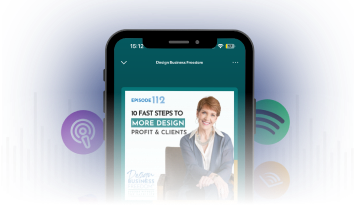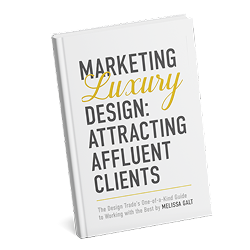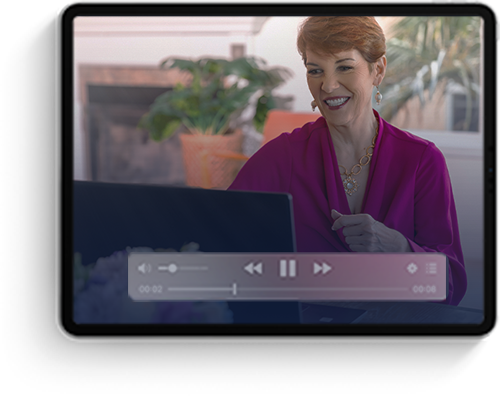Escape the Interior Design Hourly Billing Trap for More Profit
If you’re still billing by the hour, you’re working against yourself.
Hourly billing is one of the most common traps in interior design, and it’s silently eroding your client trust, your income potential, and your creative freedom. As a principal interior designer running a successful firm, you didn’t build your business to feel like a time-tracking technician. Yet that’s exactly what hourly billing demands.
It’s time to ditch the clock and adopt a smarter, more scalable approach.
Flat fees aren’t only a pricing method. They’re a business strategy that positions you as the expert you are, while giving your clients clarity and confidence.
Here are the details you need to know.
The Real Cost of Hourly Billing
Every time you send an invoice, you’re inviting scrutiny. Clients question how long things “should have” taken. They second-guess the time you spent on a design revision or a site visit. They treat your value as a commodity instead of a professional service.
You feel the pressure too. You’re constantly justifying your hours, discounting invoices to keep interior design clients comfortable, and trying to remember exactly how long you spent sourcing sconces or reworking layouts.
And let’s be honest, most designers aren’t great at tracking time. Even in large firms, the principal designer often ends up reviewing every invoice, slashing hours to smooth things over. That’s time you’re not designing, not selling, and not leading.
Worst of all, your income is capped. If you want to earn more, you have to work more. And that’s a guaranteed path to burnout.
Hourly billing keeps you small. Flat fees let you scale.
How Flat Fees Create Trust, Profit, and Professionalism
Clients aren’t buying your hours. They’re buying a transformation. A flat fee makes that investment clear and predictable.
With flat fees, clients know exactly what to expect. You eliminate surprises and empower them to plan for their design investment with confidence.
And for you? Flat fees mean:
- Predictable revenue: No chasing hours or sending uncomfortable invoices.
- Profitability you can forecast: You know your margins and can plan accordingly.
- Confidence in your value: You’re paid for your expertise, not your time.
Flat fees allow you to anchor your fees to the long-term value of the design, not how many hours it took to get there. Because let’s face it: no hourly rate, unless we’re talking $1500/hour, truly reflects your years of experience, education, and creative genius.
Now that you know hourly billing is costing you clients and creativity, it’s time to start using flat fees. These three steps will help you transition to flat fees in your interior design business with confidence.
Step 1: Choose Your Flat Fee Pricing Model
There’s no one-size-fits-all approach. The best model depends on your project type and client expectations. Here are three of the most effective:
1. Percentage of Project Investment
Ideal for large-scale renovations or high-investment projects. For example, kitchen and bath remodels often work well with a design fee of 15–20% of the renovation budget. This method requires close collaboration with contractors and builders to stay aligned on costs.
2. Square-Foot Pricing
Perfect for new builds or full-home renovations where you’re touching every surface. Whether you’re handling finishes and fixtures or managing architectural details and full furnishings, square-foot pricing creates consistency. Remember, it doesn’t work per room.
3. Per Room Fees
Simple and effective for smaller, more contained projects (think 1–5 rooms). Each room gets a design fee, with optional add-ons for procurement and markup. Be clear about what’s included (and what isn’t.) Hallways and transitional areas, for example, require their own scope and investment.
Step 2: Set and Communicate Your Fees with Confidence
Flat fees start with a clear scope of work. You need concise design deliverables with numeric boundaries. This is the foundation of a confident quote.
From there, apply your chosen pricing method. Simple math is all that’s required. Be sure to include both a payment schedule in your Letter of Agreement and scope creep protection using this phrase:
“ADDITIONS AND CHANGES REQUIRE A CHANGE ORDER AND ADDITIONAL FEES.”
When it’s time to present your fee, do it in person or via Zoom. And be ready for the question:
“What is the basis for your fee?”
Offer clear context:
- What is your design fee square foot value as a percentage of the home’s square foot value?
- What is your design fee per square foot as related to the overall square foot value of the home?
This isn’t about defending your pricing, it’s about leading with clarity and professionalism.
Step 3: Lead with The Benefits of The Transformation
When a prospect asks for your fee too early, don’t just throw out a number. Instead, say:
“We custom quote each project based on the unique scope of work and complexity of the design.”
Then reinforce the benefits:
- “This gives you clarity and confidence.”
- “It eliminates surprises and allows you to manage your investment.”
- “It ensures I can focus on delivering the best possible transformation without watching the clock.”
When you present flat fees as a premium, professional solution, clients will respect your boundaries and your expertise.
Ready to Stop Watching the Clock?
Here’s the truth: hourly billing costs you credibility, confidence, and profit. Flat fees position you as a trusted professional, free your creativity, and align your income with the true value you bring.
If you’re still billing hourly, this is your moment to stop. Not someday, now.
You’re invited to book your complimentary DESIGN BUSINESS ASSESSMENT, where we roll up our sleeves in a Zoom consultation and I’ll show you what’s possible and how to get there.





